It was grape harvest time when we traveled to the country of Georgia. Grapes seemed to be everywhere.
-
Our guide, a historian and film director, grew grapes in his yard, as did his neighbors.
-
Trucks mounded with grapes passed by as we drove through the countryside.
-
And the signature Georgian snack, churchkhela, is made with a string of shelled walnuts dipped in a thick soup of grape juice and flour.
|
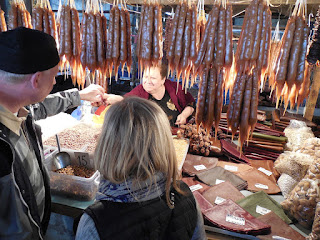
|
|
Georgian churchkhela vendor
|
Here a market woman sells her stock of churchkhela. Georgians boast that one churchkhela per day would sustain ancient Georgian warriors. It’s true. They’re a complete meal, with protein, carbs, and loads of grape-y vitamins.
Of course, as you can imagine, a countryside covered with vineyards produces more than churchkhela. Ask any Georgian: they’ll tell you that it was here that wine was invented, and you will find wine being made in factories and cellars.
|

|
|
Georgian vineyard
|
However, it was not until we visited Ikalto Monastery, an orthodox monastery begun in the 6th century, that I began to understand how deeply significant grapes are for the culture of Georgia.
|
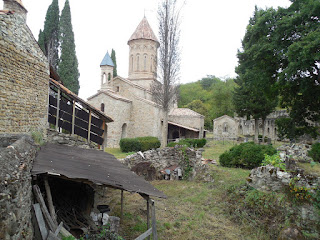
|
|
View of the ruins of the Ikalto Monastery
|
The monastery was - and still is - a large complex with grounds that once included
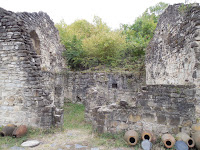
Outside the ruins of a classroom
But one cannot help but notice that scattered around the grounds are clay pots like these.
|

|
|
Clay pots
|
Often the pots are buried in the ground, as you see here.
|
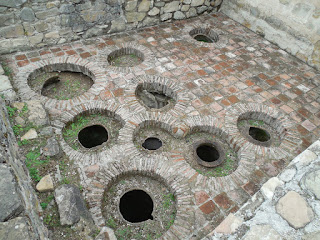
|
|
Buried clay pots
|
The key to the significance and use of these pots is this trough-like structure. Can you guess what it is?
|

|
|
The stone trough - with a channel running from it
|
It’s a wine press, and the pots are the containers that Georgians have used to make wine from before the time of this monastery to the present. Can you see the channel running from the wine press that would have led to some clay pots?
It wasn’t, however, until we visited the still-functioning, ancient Church of the Holy Trinity on the grounds that I began to understand the significance of wine for Georgian culture.
|
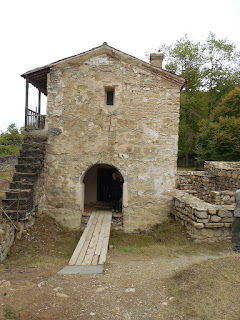
|
|
Holy Trinity Church
|
As you walk up to the door, you see this ancient sculpture of the Trinity inside the entryway.
|
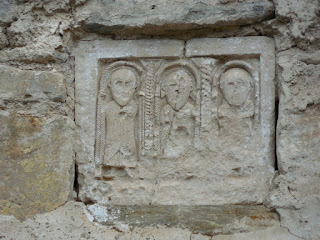
|
|
Sculpture depicting the Trinity
|
Inside is the expected iconostasis of Orthodox churches.
|
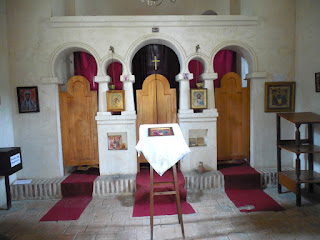
|
|
Iconostasis
|
But on the wall to our left is an icon, and, like they say, a picture is worth a thousand words. Wordlessly, it explains the deep significance of wine in Georgian culture.
|
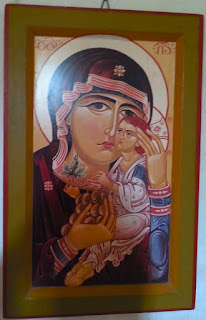
|
|
Icon with Virgin, Child, and grapes
|
The Virgin Mary is holding the Christ-child - AND A CLUSTER OF GRAPES! It seems odd at first. Is the icon saying that the Virgin is a drunkard? Of course not! The grapes tell us, not about the Mother, but about the Child:
It’s inescapable. To a Georgian, wine seems to be more than a pleasant dinner drink. It’s also becomes a reference to the Orthodox faith that is central to Georgian culture.
Learn to draw a stained glass window depicting the Virgin Mary with the Christ child here.
It was grape harvest time when we traveled to the country of Georgia. Grapes seemed to be everywhere.
-
Our guide, a historian and film director, grew grapes in his yard, as did his neighbors.
-
Trucks mounded with grapes passed by as we drove through the countryside.
-
And the signature Georgian snack, churchkhela, is made with a string of shelled walnuts dipped in a thick soup of grape juice and flour.
|

|
|
Georgian churchkhela vendor
|
Here a market woman sells her stock of churchkhela. Georgians boast that one churchkhela per day would sustain ancient Georgian warriors. It’s true. They’re a complete meal, with protein, carbs, and loads of grape-y vitamins.
Of course, as you can imagine, a countryside covered with vineyards produces more than churchkhela. Ask any Georgian: they’ll tell you that it was here that wine was invented, and you will find wine being made in factories and cellars.
|

|
|
Georgian vineyard
|
However, it was not until we visited Ikalto Monastery, an orthodox monastery begun in the 6th century, that I began to understand how deeply significant grapes are for the culture of Georgia.
|

|
|
View of the ruins of the Ikalto Monastery
|
The monastery was - and still is - a large complex with grounds that once included

Outside the ruins of a classroom
But one cannot help but notice that scattered around the grounds are clay pots like these.
|

|
|
Clay pots
|
Often the pots are buried in the ground, as you see here.
|

|
|
Buried clay pots
|
The key to the significance and use of these pots is this trough-like structure. Can you guess what it is?
|

|
|
The stone trough - with a channel running from it
|
It’s a wine press, and the pots are the containers that Georgians have used to make wine from before the time of this monastery to the present. Can you see the channel running from the wine press that would have led to some clay pots?
It wasn’t, however, until we visited the still-functioning, ancient Church of the Holy Trinity on the grounds that I began to understand the significance of wine for Georgian culture.
|

|
|
Holy Trinity Church
|
As you walk up to the door, you see this ancient sculpture of the Trinity inside the entryway.
|

|
|
Sculpture depicting the Trinity
|
Inside is the expected iconostasis of Orthodox churches.
|

|
|
Iconostasis
|
But on the wall to our left is an icon, and, like they say, a picture is worth a thousand words. Wordlessly, it explains the deep significance of wine in Georgian culture.
|

|
|
Icon with Virgin, Child, and grapes
|
The Virgin Mary is holding the Christ-child - AND A CLUSTER OF GRAPES! It seems odd at first. Is the icon saying that the Virgin is a drunkard? Of course not! The grapes tell us, not about the Mother, but about the Child:
It’s inescapable. To a Georgian, wine seems to be more than a pleasant dinner drink. It’s also becomes a reference to the Orthodox faith that is central to Georgian culture.
Learn to draw a stained glass window depicting the Virgin Mary with the Christ child here.
It was grape harvest time when we traveled to the country of Georgia. Grapes seemed to be everywhere.
-
Our guide, a historian and film director, grew grapes in his yard, as did his neighbors.
-
Trucks mounded with grapes passed by as we drove through the countryside.
-
And the signature Georgian snack, churchkhela, is made with a string of shelled walnuts dipped in a thick soup of grape juice and flour.
|

|
|
Georgian churchkhela vendor
|
Here a market woman sells her stock of churchkhela. Georgians boast that one churchkhela per day would sustain ancient Georgian warriors. It’s true. They’re a complete meal, with protein, carbs, and loads of grape-y vitamins.
Of course, as you can imagine, a countryside covered with vineyards produces more than churchkhela. Ask any Georgian: they’ll tell you that it was here that wine was invented, and you will find wine being made in factories and cellars.
|

|
|
Georgian vineyard
|
However, it was not until we visited Ikalto Monastery, an orthodox monastery begun in the 6th century, that I began to understand how deeply significant grapes are for the culture of Georgia.
|

|
|
View of the ruins of the Ikalto Monastery
|
The monastery was - and still is - a large complex with grounds that once included

Outside the ruins of a classroom
But one cannot help but notice that scattered around the grounds are clay pots like these.
|

|
|
Clay pots
|
Often the pots are buried in the ground, as you see here.
|

|
|
Buried clay pots
|
The key to the significance and use of these pots is this trough-like structure. Can you guess what it is?
|

|
|
The stone trough - with a channel running from it
|
It’s a wine press, and the pots are the containers that Georgians have used to make wine from before the time of this monastery to the present. Can you see the channel running from the wine press that would have led to some clay pots?
It wasn’t, however, until we visited the still-functioning, ancient Church of the Holy Trinity on the grounds that I began to understand the significance of wine for Georgian culture.
|

|
|
Holy Trinity Church
|
As you walk up to the door, you see this ancient sculpture of the Trinity inside the entryway.
|

|
|
Sculpture depicting the Trinity
|
Inside is the expected iconostasis of Orthodox churches.
|

|
|
Iconostasis
|
But on the wall to our left is an icon, and, like they say, a picture is worth a thousand words. Wordlessly, it explains the deep significance of wine in Georgian culture.
|

|
|
Icon with Virgin, Child, and grapes
|
The Virgin Mary is holding the Christ-child - AND A CLUSTER OF GRAPES! It seems odd at first. Is the icon saying that the Virgin is a drunkard? Of course not! The grapes tell us, not about the Mother, but about the Child:
It’s inescapable. To a Georgian, wine seems to be more than a pleasant dinner drink. It’s also becomes a reference to the Orthodox faith that is central to Georgian culture.
Learn to draw a stained glass window depicting the Virgin Mary with the Christ child here.


